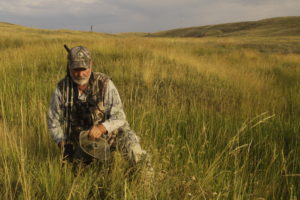Not everyone puts up their predator hunting gear as the summer season takes off. A few hardy hunters keep the pressure on predators, especially coyotes, that may be preying on wildlife or domestic livestock.
Whether you hope to save a fawn or just experience the fun of a face to face with your favorite predator, there are some unique circumstances you’ll need to be prepared to handle.
HIPPIE LANDSCAPE
Unless you plan to hunt the Arctic ice get ready to hunt a landscape that needs a haircut. Late spring and summer landscapes sport a bounty of vegetation. That’s great for wildlife. Nesting birds and young mammals find sanctuary in the newfound jungle.
Unfortunately, so do coyotes. In nearly all environments, outside of the desert Southwest, vegetation springs up and easily conceals coyotes. That means you’ll have to scout harder to find settings that will force a coyote into shooting lanes with adequate shooting visibility.
There is one bonus ahead. Hay harvesting begins soon and that clears acres of tall grass for the best view in the county. Another bonus to haying is the fact coyotes oftentimes visit these bare fields for easier hunting of rodents. Keep in touch with local landowners and once the haying is complete you may discover the perfect summer setup site.
BITING BUGS, SEARING SUN
Two villains accompany the warm season: bugs and sunburn. Both may seem like minor irritants, but both have an evil side. Insects like ticks, mosquitos and fleas definitely should be a top concern according to the Centers for Disease Control and Prevention.
“Illnesses from mosquito, tick and flea bites have tripled in the U.S., with more than 640,000 cases reported during the 13 years from 2004 through 2016. Nine new germs spread by mosquitoes and ticks were discovered or introduced into the United States during this time. Zika, West Nile, Lyme and chikungunya—a growing list of diseases caused by the bite of an infected mosquito, tick, or flea—have confronted the U.S. in recent years, making a lot of people sick.”

Summer can be challenging for predator hunters seeking action, but don't give up despite the tough hunting. Mornings and evenings can be super times to put songdogs on the dirt. (Photo: Mark Kayser)
All of these insects, and others, could invade your summer predator hunt. If you do bag a predator, especially a coyote, fleas particularly should be of concern. Don’t spend too much time admiring your trophy.
Wear long-sleeved shirts, use a product such as a Thermacell and apply insect repellent as directed. If you utilize scent elimination products, such as Scent Killer and a downwind position, you shouldn’t have to worry about a predator scenting you and you’ll hopefully avoid a hospital visit.
The same is true of sun exposure. Skin cancer, or as it is known by professionals, melanoma, is the most deadly of cancers. Approximately 65 percent of cases are linked directly back to exposure of ultraviolet rays. For most hunters a tanning bed is not the culprit, exposure to the sun is and the CDC advises long sleeves, wide-brimmed hats, sunglasses, staying in the shade and wearing sunscreen with an SPF rating of 15, or higher.
Lastly, keep a watch out for any venomous reptiles. Rattlesnakes, copperheads and cottonmouths top the list of North America’s most venomous snakes. Look down as you hike, listen for warning signs and check every location before you sit.
IN-YOUR-FACE ACTION
It’s no secret the days heat up during the race to summer. You don’t appreciate being out in the hot sun and neither do most predators. Your mission is to find areas of shade where coyotes may seek relief from the Al Gore weather phenomena of global warming.
First and last setups should always concentrate on the cooler periods of dawn and dusk. In between, try to call coyotes from cooler areas like under tree canopies and near flowing water. Shade, hydration and cooler temperatures all add up to more coyote encounters during summer.
In the early part of the summer you can bring coyotes running by using canine vocalizations such as howls, barks and pup in distress sounds. Coyotes will respond to see who’s invading their homeland and try and drive the invaders away from dens.
Once pups begin venturing from the den site you can rely heavily on prey in distress. There are two reasons for this. First, adult coyotes have to hunt harder since the growing pups require more and more food every day. Second, as mom and dad leave the den for hunting chores the kids will be left alone.
Begin keying in on young coyotes in July with a peak in August as pups venture further and eventually leave home for good. Nonthreatening calls are your best option. Focus on easy prey that pups will be attracted to for an easy meal. An obvious call is the rabbit in distress, but rodent squeaking, songbird distress and chicken squawks also will attract juvenile coyotes.
Summer predator hunting has its challenges, but if you plan accordingly it can be a better experience than you’d find at the local golf course.
Featured image: Mark Kayser






